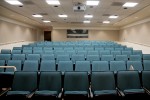BruinCast is perhaps the third-greatest invention of mankind, inferior only to the smartphone and Wi-Fi – at least for UCLA students.
Fall quarter enrollment is fast approaching, and students will soon begin consulting everything from professors’ Bruinwalk.com ratings to MyUCLA’s class availability to craft the optimal schedule. But perhaps one of the most important factors that influences students’ decision to enroll in a class is whether the class is available on BruinCast.
BruinCast allows professors to webcast their lectures via audio or video for their students or the general public. According to UCLA’s Office of Instructional Development, which is in charge of BruinCast, only about 25 percent of classes offered at UCLA are available on BruinCast.
Many professors, however, don’t know about this facility and its benefits. Furthermore, the university does not allocate enough resources and funding for BruinCast, notably limiting the total number of classes that can be broadcasted. And that’s a problem for many students, such as those trying to overcome a language barrier or those who want supplemental material to study for their classes.
As such, UCLA should inform professors of its advantages and make more lecture halls technologically suitable for audio and video podcasting. Doing so would allow the university to make more classes available on BruinCast and better serve students.
BruinCast allows students to fully pay attention and absorb the information they’re taught in lecture. With UCLA’s fast-paced quarter system, students sometimes miss important points while trying to write down everything on the projector screen or blackboard before the professor switches to another slide or erases the board.
BruinCast enables students to go back and note down lecture material on their own time, so they can properly engage with the lecture material, ask questions and understand what is being taught in class. And this is the primary reason why most professors who use BruinCast believe it is conducive to the learning experience.
“I use BruinCast because it allows my students to actively process information in class, which increases their retention of the material,” said psychology lecturer Julie Smurda.
BruinCast also caters to those with special needs and even non-native English speakers, many of whom may have difficulty understanding professors or keeping up with the fast pace of UCLA classes.
BruinCast also provides for students who have to miss class for serious reasons, such as taking care of their health. Students who have missed a lecture are often forced to schedule extra appointments with professors and teaching assistants or use up time during office hours to catch up. BruinCast instead allows them to simply watch what they missed in their own time, and use office hours to clarify doubts and to reinforce concepts. Students can even rewatch lectures to review before exams.
Two problems, however, prevent BruinCast from becoming mainstream. First, most professors don’t know that such a service is available to them. Second, most lecture halls are not equipped with the technology to record lectures.
“I only know about (BruinCast) because my students told me and I have found that it’s a huge advantage to their learning,” said Amy Fluitt, a life sciences instructor.
In other words, not all professors know they can request to BruinCast their lectures. That’s troubling since the demand for recorded classes is clearly there among students.
To make matters worse, only three halls on campus, Haines 39, Humanities A51 and La Kretz 110 have the appropriate technology for video streaming, according to the OID. Thirty-seven lecture halls support audio-only podcasting.
While classes held in other lecture halls can also be recorded using external technical and human resources, lecture halls with the appropriate technology for video recording are prioritized, as stated on the OID’s website. This means that even if professors opt to have their lectures on BruinCast, their requests can be denied if their classes aren’t held in streaming-equipped rooms.
“I requested to record my 8 a.m. lecture this quarter, but was unable to do so because of a last minute room change to Fowler A103B,” said mathematics professor Noah White. “The new room just did not have the tools to do so.”
It’s clear the OID needs to spread more awareness and inform new professors about BruinCast and its benefits so more professors would be willing to record their lectures.
In addition, UCLA needs to increase funding for BruinCast to ensure more lecture halls have the technology required to record lectures. As more professors request their classes be BruinCasted, the resources to meet that demand need to be there.
However, professors are right to be concerned that BruinCast can discourage lecture attendance.
“BruinCast significantly reduces class attendance and I believe that listening to the professor and taking notes is always a more effective way of learning than watching a lecture on a screen,” said Meric Keskinel, an economics professor.
However, the OID has suggestions to prevent this. Professors should tell their students that not coming to lecture will adversely affect their grade and remind them about the importance of attending lectures. They can also provide additional incentives for them to attend class. Doing so would restore attendance to pre-BruinCast levels.
It is crucial that UCLA finds ways to make more lecture halls suitable for streaming and inform more professors about the service and its advantages. Doing so would increase the number of classes available on BruinCast and truly enhance students’ learning experience.
Last I checked, that’s a recipe for a top-class education.
